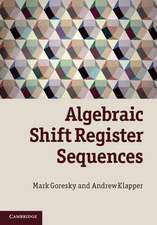Linear Analysis and Representation Theory: Grundlehren der mathematischen Wissenschaften, cartea 198
Autor Steven A. Gaalen Limba Engleză Paperback – 15 dec 2011
Din seria Grundlehren der mathematischen Wissenschaften
-
 Preț: 353.84 lei
Preț: 353.84 lei - 24%
 Preț: 728.15 lei
Preț: 728.15 lei -
 Preț: 410.21 lei
Preț: 410.21 lei - 24%
 Preț: 587.87 lei
Preț: 587.87 lei - 17%
 Preț: 498.73 lei
Preț: 498.73 lei -
 Preț: 592.75 lei
Preț: 592.75 lei - 20%
 Preț: 692.49 lei
Preț: 692.49 lei - 24%
 Preț: 893.28 lei
Preț: 893.28 lei - 20%
 Preț: 824.73 lei
Preț: 824.73 lei - 24%
 Preț: 632.96 lei
Preț: 632.96 lei - 15%
 Preț: 596.69 lei
Preț: 596.69 lei - 15%
 Preț: 714.49 lei
Preț: 714.49 lei -
 Preț: 333.01 lei
Preț: 333.01 lei - 15%
 Preț: 473.16 lei
Preț: 473.16 lei -
 Preț: 356.49 lei
Preț: 356.49 lei -
 Preț: 484.43 lei
Preț: 484.43 lei - 15%
 Preț: 452.79 lei
Preț: 452.79 lei -
 Preț: 456.66 lei
Preț: 456.66 lei - 15%
 Preț: 708.75 lei
Preț: 708.75 lei -
 Preț: 423.08 lei
Preț: 423.08 lei - 15%
 Preț: 444.29 lei
Preț: 444.29 lei - 15%
 Preț: 527.79 lei
Preț: 527.79 lei - 15%
 Preț: 589.65 lei
Preț: 589.65 lei -
 Preț: 353.40 lei
Preț: 353.40 lei - 18%
 Preț: 727.66 lei
Preț: 727.66 lei -
 Preț: 387.96 lei
Preț: 387.96 lei - 15%
 Preț: 454.74 lei
Preț: 454.74 lei - 15%
 Preț: 481.03 lei
Preț: 481.03 lei -
 Preț: 464.55 lei
Preț: 464.55 lei -
 Preț: 348.77 lei
Preț: 348.77 lei -
 Preț: 362.04 lei
Preț: 362.04 lei -
 Preț: 488.12 lei
Preț: 488.12 lei - 15%
 Preț: 447.57 lei
Preț: 447.57 lei -
 Preț: 419.81 lei
Preț: 419.81 lei -
 Preț: 388.52 lei
Preț: 388.52 lei -
 Preț: 419.21 lei
Preț: 419.21 lei - 15%
 Preț: 581.01 lei
Preț: 581.01 lei -
 Preț: 497.75 lei
Preț: 497.75 lei -
 Preț: 360.53 lei
Preț: 360.53 lei -
 Preț: 387.75 lei
Preț: 387.75 lei -
 Preț: 419.81 lei
Preț: 419.81 lei - 18%
 Preț: 725.75 lei
Preț: 725.75 lei -
 Preț: 453.78 lei
Preț: 453.78 lei -
 Preț: 386.39 lei
Preț: 386.39 lei
Preț: 658.88 lei
Preț vechi: 775.14 lei
-15% Nou
Puncte Express: 988
Preț estimativ în valută:
126.09€ • 130.89$ • 105.14£
126.09€ • 130.89$ • 105.14£
Carte tipărită la comandă
Livrare economică 22 martie-05 aprilie
Preluare comenzi: 021 569.72.76
Specificații
ISBN-13: 9783642807435
ISBN-10: 3642807437
Pagini: 708
Ilustrații: X, 690 p.
Dimensiuni: 152 x 229 x 37 mm
Greutate: 0.93 kg
Ediția:Softcover reprint of the original 1st ed. 1973
Editura: Springer Berlin, Heidelberg
Colecția Springer
Seria Grundlehren der mathematischen Wissenschaften
Locul publicării:Berlin, Heidelberg, Germany
ISBN-10: 3642807437
Pagini: 708
Ilustrații: X, 690 p.
Dimensiuni: 152 x 229 x 37 mm
Greutate: 0.93 kg
Ediția:Softcover reprint of the original 1st ed. 1973
Editura: Springer Berlin, Heidelberg
Colecția Springer
Seria Grundlehren der mathematischen Wissenschaften
Locul publicării:Berlin, Heidelberg, Germany
Public țintă
ResearchCuprins
I. Algebras and Banach Algebras.- 1. Algebras and Norms.- 2. The Group of Units and the Quasigroup.- 3. The Maximal Ideal Space.- 4. The Spectrum of an Element.- 5. The Spectral Norm Formula.- 6. Commutative Banach Algebras and their Ideals.- 7. Radical and Semisimplicity.- 8. Involutive Algebras.- 9. H* Algebras.- Remarks.- II. Operators and Operator Algebras.- 1. Topologies on Vector Spaces and on Operator Algebras.- 2. Compact Operators.- 3. The Spectral Theorem for Compact Operators.- 4. Hilbert-Schmidt Operators.- 5. Trace Class Operators.- 6. Vector Valued Line Integrals.- 7. Homomorphisms into A. The Spectral Mapping Theorem.- 8. Unbounded Operators.- Remarks.- III. The Spectral Theorem, Stable Subspaces and v. Neumann Algebras.- 1. Linear Functionals on Vector Lattices and their Extensions.- 2. Linear Functionals on Lattices of Functions.- 3. The Spectral Theorem for SelfAdjoint Operators in Hilbert Space.- 4. Normal Elements and Normal Operators.- 5. Stable Subspaces and Commutants.- 6. von Neumann Algebras.- 7. Measures on Locally Compact Spaces.- Remarks.- IV. Elementary Representation Theory in Hilbert Space.- 1. Representations and Morphisms.- 2. Irreducible Components, Equivalence.- 3. Intertwining Operators.- 4. Schur’s Lemma.- 5. Multiplicity of Irreducible Components.- 6. The General Trace Formula.- 7. Primary Representations and Factorial v. Neumann Algebras.- 8. Algebras and Representations of Type I.- 9. Type II and III v. Neumann Algebras.- Remarks.- Preliminary Remarks to Chapter V.- V. Topological Groups, Invariant Measures, Convolutions and Representations.- 1. Topological Groups and Homogeneous Spaces.- 2. Haar Measure.- 3. Quasi-Invariant and Relatively Invariant Measures.- 4. Convolutions of Functions and Measures.- 5. The AlgebraRepresentation Associated with ?:S??(?).- 6. The Regular Representations of Locally Compact Groups.- 7. Continuity of Group Representations and the Gelfand-Raikov Theorem.- Remarks.- VI. Induced Representations.- 1. The Riesz-Fischer Theorem.- 2. Induced Representations when G/H has an Invariant Measure.- 3. Tensor Products.- 4. Induced Representations for Arbitrary G and H.- 5. The Existence ofa Kernel for L1(G)??(K).- 6. The Direct Sum Decomposition of the Induced Representation ?:G?u(K).- 7. The Isometric Isomorphism between ?2 and HS(K2, K1). The Computation of the Trace in Terms of the Associated Kernel.- 8. The Tensor Product of Induced Representations.- 9. The Theorem on Induction in Stages.- 10. Representations Induced by Representations of Conjugate Subgroups.- 11. Mackey’s Theorem on Strong Intertwining Numbers and Some of its Consequences.- 12. Isomorphism Theorems Implying the Frobenius Reciprocity Relation.- Remarks.- VII. Square Integrable Representations, Spherical Functions and Trace Formulas.- 1. Square Integrable Representations and the Representation Theory of Compact Groups.- 2. Zonal Spherical Functions.- 3. Spherical Functions of Arbitrary Type and Height.- 4. Godement’s Theorem on the Characterization of Spherical Functions.- 5. Representations of Groups with an Iwasawa Decomposition.- 6. Trace Formulas.- Remarks.- VIII. Lie Algebras, Manifolds and Lie Groups.- 1. Lie Algebras.- 2. Finite Dimensional Representations of Lie Algebras. Cartan’s Criteria and the Theorems of Engel and Lie.- 3. Presheaves and Sheaves.- 4. Differentiable Manifolds.- 5. Lie Groups and their Lie Algebras.- 6. The Exponential Map and Canonical Coordinates.- 7. Lie Subgroups and Subalgebras.- 8. Invariant Lie Subgroups and Quotients of Lie Groups. TheProjective Groups and the Lorentz Group.- Remarks.- Index of Notations and Special Symbols.















